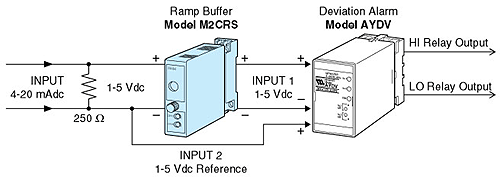In this application, an alarm is required
when the process signal changes too rapidly. This can be used to detect
a faulty valve creating a fast back-pressure a broken pipe which is allowing
a flow rate to increase too quickly.
A contact closure is needed to shutdown the process and energize an annunciator
if this "process upset" occurs. The combination of the model M2CRS
and the model AYDV (deviation alarm) can provide this control.
The diagram below shows the M2CRS input signal as the "reference"
input 2 to the model AYDV, and the output of the M2CRS as the "measuring"
input 1 to the AYDV. It is necessary to determine the fastest acceptable
rate-of-change under normal operating conditions and set this rate as the
response time of the M2CRS unit. As long as the signal changes within this
rate-of-change limit, the input and the output of the M2CRS are identical.
These two equal signals are sensed by the AYDV which causes the output relay
to remain untripped (NO ALARM).
When the process signal begins to change faster than the acceptable amount,
the M2CRS output starts limiting its rate of change. The AYDV input 2 continues
to track the rapid changing signal causing a deviation to occur between
it and the input 1. When this deviation reaches the set value on the AYDV,
the output relay is then tripped (ALARM). |

